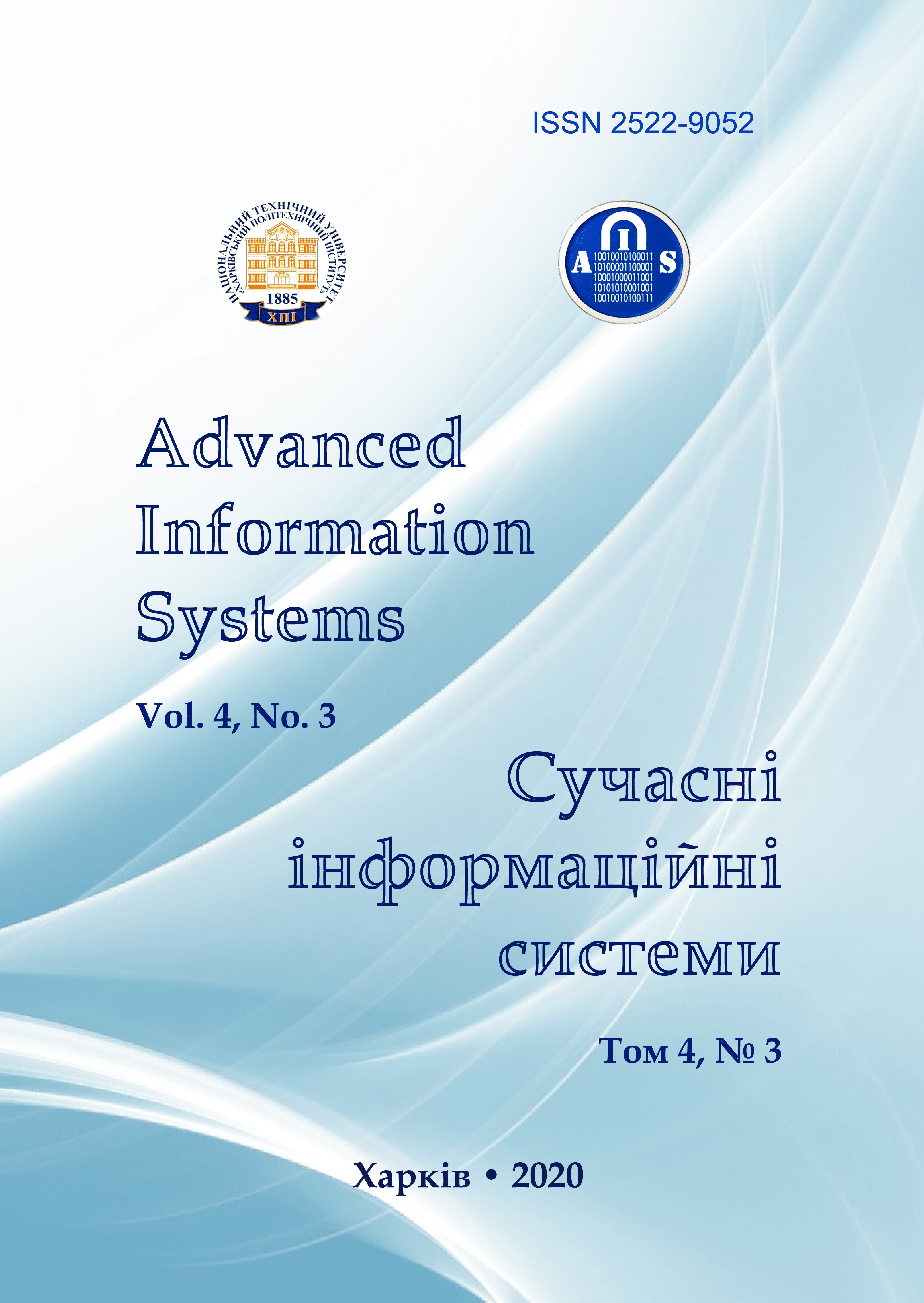THE IMPROVED MODEL OF USER SIMILARITY COEFFICIENTS COMPUTATION FOR RECOMMENDATION SYSTEMS
Main Article Content
Abstract
Article Details
References
(2010), Recommender Systems Handbook, Editors Francesco Ricci, Lior Rokach, Bracha Shapira, Paul B. Kantor, 1st edition, New York, NY, USA: Springer-Verlag New York, Inc., 842 p., available at: https://doi.org/10.1007/978-0-387-85820-3
Segaran, T. (2008), Programming Collective Intelligence, Building Smart Web 2.0 Applications, O'Reilly Media, 368 p.
Koren, Ye. (2009), “Collaborative filtering with temporal dynamics”, Proceeding KDD '09 Proceedings of the 15th ACM SIGKDD international conference on Knowledge discovery and data mining, P. 447-456.
Meleshko, Ye. (2018), “Research of methods of building advisory systemson the internet”, Control, Navigation and Communication Systems, Issue 1 (47), pp. 131-136, DOI: https://doi.org/10.26906/SUNZ.2018.1.131 (in Ukrainian).
Meleshko, Ye. (2018), “Method of collaborative filtration based on associative networks of users similarity”, Advanced Information Systems, Vol. 2, No. 4, pp. 55-59, DOI: https://doi.org/10.20998/2522-9052.2018.4.09
Cao, J., Hu, H., Luo, T., Wang, J., Huang, M., Wang K., Wu Z. and Zhang, X. (2015), “Distributed Design and Implementation of SVD++ Algorithm for E-commerce Personalized Recommender System”, Communications in Computer and Information Science, Vol. 572, Springer Singapore, pp. 30-44, DOI: 10.1007/978-981-10-0421-6_4
Jia, Ya. (2014), “Users' brands preference based on SVD++ in recommender systems”, IEEE Workshop on Advanced Research and Technology in Industry Applications, pp. 1175-1178, DOI: 10.1109/wartia.2014.6976489
Huba, Gaspar (2015), The Cold Start Problem for Recommender Systems, available at:
https://www.yuspify.com/blog/cold-start-problem-recommender-systems/
Bernardi, L., Kamps, J., Kiseleva, J. and Mueller, M.J.I. (2015), The Continuous Cold Start Problem in e-Commerce Recommender Systems, available at: https://www.researchgate.net/publication/280773072_The_Continuous_Cold_Start_ Problem_in_e-Commerce_Recommender_Systems
Meleshko, Ye. (2018), “Problems of modern recommendation systems and methods of their solution”, Control, Navigation and Communication Systems, Issue 4 (50), pp. 120-124, available at: https://doi.org/10.26906/SUNZ.2018.4.120
Menshykova, N.V., Portnov, I.V. and Nikolayev, I.E. (2016), “The overview of recommender systems and the possibility of context accounting in the formation of individual recommendations”, ACADEMY, Issue 6, pp. 20–22 (in Russian)
Kotkov, D., Konstan, J.A., Zhao, Q. and Veijalainen, J. (2018), Investigating Serendipity in Recommender Systems Based on Real User Feedback, available at: https://www-users.cs.umn.edu/~zhaox331/papers/denis2018sac.pdf
Castells, P., Vargas, S. and Wang, J. (2011), Novelty and Diversity Metrics for Recommender Systems: Choice, Discovery and Relevance, available at: https://www.semanticscholar.org/paper/Novelty-and-Diversity-Metrics-for-Recommender-and-Castells-Vargas/4ec6bd672aaaa075b42a751099eb9317857e6e0
Amelkin. S.A. (2012). “Evaluation of the effectiveness of recommender systems”, Digital Libraries: Advanced Methods and Technologies, Digital Collections - RCDL-2012, Pereslavl-Zalessky, October 15-18, 2012, pp. 288-291. (in Russian)
Burke, R. (2002), Hybrid Recommender Systems: Survey and Experiments. User Modeling and User-Adapted Interaction, vol. 12, DOI: https://doi.org/10.1023/A:1021240730564
Ozsoy, M.G. and Polat, F. (2013), “Trust based recommendation systems”, 2013 IEEE/ACM International Conference on Advances in Social Networks Analysis and Mining, pp. 1267-1274.
Mohammadi, V., Rahmani, A.M., Darwesh, A.M. and Sahafi, A. (2019), “Trust-based recommendation systems in Internet of Things: a systematic literature review”, Human-centric Computing and Information Sciences, DOI: https://doi.org/10.1186/s13673-019-0183-8
Lin, Z. and Chen, H. (2019), Recommendation over time: a probabilistic model of time-aware recommender systems, Sci. China Inf. Sci. 62, 212105, DOI: https://doi.org/10.1007/s11432-018-9915-8
Wei, S., Ye, N. and Zhang, Q. (2012), “Time-Aware Collaborative Filtering for Recommender Systems”, Liu CL., Zhang C., Wang L. (eds) Pattern Recognition. CCPR 2012, Communications in Computer and Information Science, vol 321. Springer, Berlin, Heidelberg.
Campos, P.G., Díez, F. & Cantador I. (2014), “Time-aware recommender systems: a comprehensive survey and analysis of existing evaluation protocols”, User Model User-Adap Inter 24, P. 67-119, DOI: https://doi.org/10.1007/s11257-012-9136-x
Quan, Yuan, Gao, Cong, Zongyang, Ma, Aixin, Sun and Nadia, Magnenat-Thalmann (2013), “Time-aware point-of-interest recommendation”, Proceedings of the 36th international ACM SIGIR conference on Research and development in information retrieval (SIGIR ’13), Association for Computing Machinery, New York, NY, USA, 363-372. DOI: https://doi.org/10.1145/2484028.2484030
Liu, N.N., Zhao, M., Xiang E.W. and Yang, Q. (2010), “Online evolutionary collaborative filtering”, Amatriain, X., Torrens, M., Resnick, P., Zanker, M. (eds.) RecSys. pp. 95–102.
Ding, Y., Li X. (2005), “Time weight collaborative filtering”, Proceedings of the 14th ACM international conference on Information and knowledge management (CIKM ’05), Association for Computing Machinery, New York, NY, USA, P. 485-492, DOI: https://doi.org/10.1145/1099554.1099689
Semenov, S.G., Gavrylenko, S.Y. and Chelak, V.V. (2016), “Developing parametrical criterion for registering abnormal behavior in computer and telecommunication systems on the basis of economic tests”, Actual Problems of Economics, Issue 4(178), pp. 451-459.
Semenov, S., Dorokhov, O. and Grynov, D. (2013), “The concept definition of mathematical modelling of the secured information-telecommunication system with regard to conditions of the posterior uncertainty”, Transport and Telecommunication, Vol. 14, No 2, pp. 167-174.
Harper, F.M. and Konstan, J.A. (2016), “The MovieLens Datasets: History and Context”, ACM Transactions on Interactive Intelligent Systems (TiiS), available at: https://doi.org/10.1145/2827872
Rukosuev, A., Bashlykov, V. and Baldin, K. (2011), Fundamentals of Probability Theory and Mathematical Statistics, Textbook, Flinta, Moscow, 980 p. (in Russian).
Klimov, A.N. (1985), Nuclear Physics and Nuclear Reactors, Energoatomizdat, Moscow, 352 p. (in Russian).
